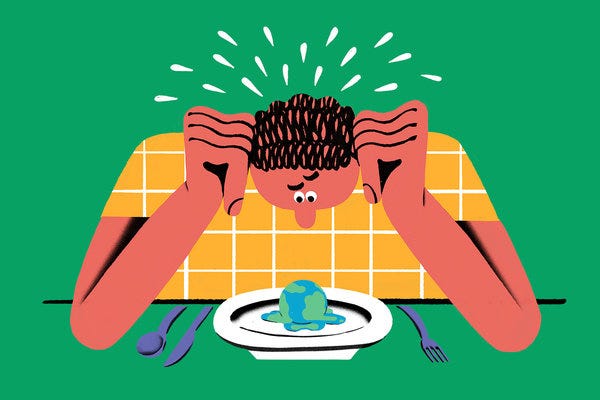“The Hidden Environmental Costs of Food Damage to the natural world isn’t factored into the price of food. But some governments are experimenting with a new way of exposing the larger costs….”
Given this piece is founded on the environmental/hypothetical, this is just another example of Greenwishing the planet and its inhabitants.
The Hidden Environmental Costs of Food
Damage to the natural world isn’t factored into the price of food. But some governments are experimenting with a new way of exposing the larger costs of what we eat.
Share full article
386
By Lydia DePillis, Manuela Andreoni and Catrin Einhorn
Illustrations by Allie Sullberg
Sept. 19, 2024
As pricey as a run to the grocery store has become, our grocery bills would be considerably more expensive if environmental costs were included, researchers say. The loss of species as cropland takes over habitat. Groundwater depletion. Greenhouse gases from manure and farm equipment.
For years, economists have been developing a system of “true cost accounting” based on a growing body of evidence about the environmental damage caused by different types of agriculture. Now, emerging research aims to translate this damage to the planet into dollar figures.
By displaying these so-called true prices, sometimes next to retail prices, researchers hope to nudge consumers, businesses, farmers and regulators to factor in the environmental toll of food.
The proponents of true cost accounting don’t propose raising food prices across the board, but they say that increased awareness of the hidden environmental cost of food could change behavior.
We asked True Price, a Dutch nonprofit group that has pioneered true cost accounting alongside the United Nations and the Rockefeller Foundation, to provide a window into some of their research. They came up with a data set that compares the estimated environmental costs of common foods produced in the United States, divided into three categories: Climate change caused by greenhouse gas emissions, water usage, and ecosystem effects from land use, including loss of biodiversity.
“These costs are going to be paid,” said Claire van den Broek, managing director at True Price. “They’re paid in the healthcare system, in climate adaptation mechanisms, and those will come back in taxes. It’s not like these costs are fictional.”
We ran True Price’s methodology by other experts, who found it to be generally sound, if sometimes vague. As higher quality data becomes available, they said, the efforts to quantify the environmental impact of food should improve. (True cost accounting also typically includes things like labor rights and dietary health, but here we’re focusing on environmental costs.)
Alexander Müller, founder of the TMG Think Tank for Sustainability, a research organization based in Berlin, has worked with True Price for some specific analyses and has reviewed its approach in depth. “While we believe that True Price’s methodology has some shortcomings, it is among the best available given our current knowledge,” he said, noting that he did not think responsibility for changing consumption should be placed on the individual.
One of the biggest criticisms of true cost accounting is how hard it is to calculate a specific dollar amount for costs that are so diffuse and ignored in the market. Even its supporters acknowledge that it’s inherently imprecise. Other economists say the figures can amount to not much more than guesses.
More on What to Eat
Your Questions About Food and Climate Change, Answered
New Diet Guidelines to Benefit People and the Planet: More Greens for All, Less Meat for Some
“There’s so much variety in how things are produced that I’m skeptical of attempts to put any number on the environmental costs of doing something,” said Scott Swinton, a professor of agricultural economics at Michigan State University.
Roger Cryan, chief economist at the American Farm Bureau Federation, a group that represents farmers, faults true cost analyses for undervaluing the benefits of affordable food.
Nevertheless, some governments are using this research to design policies that account for food’s environmental effects. New York State, for example, is working with Cornell University researchersto develop a tool to factor them into procurement decisions, rather than just picking the cheapest bid. And Denmark is introducing the world’s first tax on methane emitted by cows, pigs and sheep.
Large disparities between the retail price of food and its environmental costs are found in the proteins many of us eat every day. This article used prices from Walmart.com, the largest U.S. grocery retailer, because government averages were not available for some protein sources. It does not include an example of fish because environmental damage from fisheries is harder to assess and compare with impacts on land, True Price researchers said.






